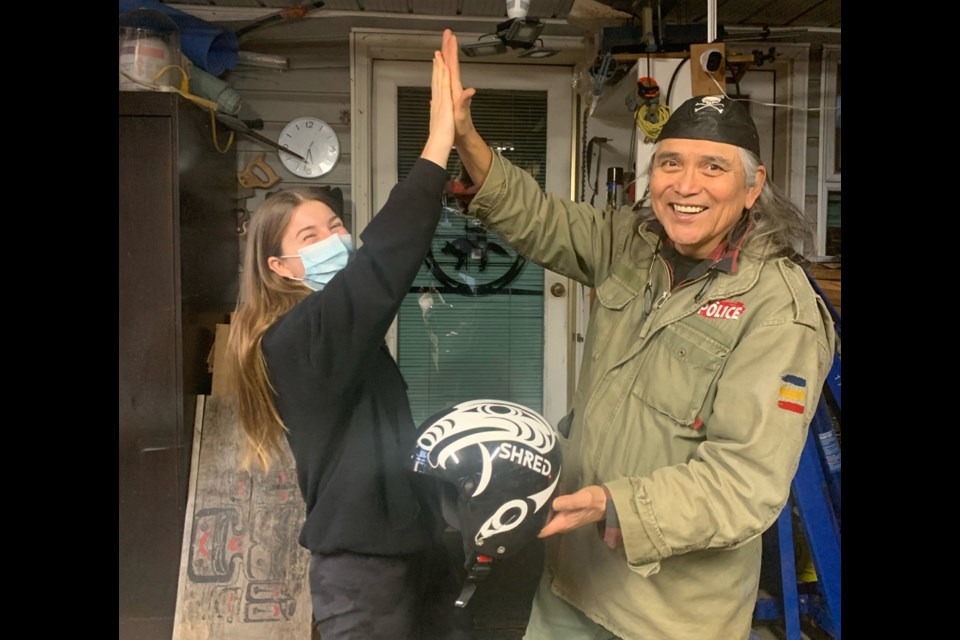When West Vancouver’s Mollie Jepsen blasts out of the starting gate at the Paralympic Games, she’ll be wearing a piece of equipment that will offer her protection while also providing a powerful connection to her homeland.
The 22-year-old alpine skier – who was a star of the 2018 Paralympics in Pyeongchang, where she won four medals – will wear a brand new helmet featuring Coast Salish designs created by famed Squamish Nation artist Xwalacktun (Rick Harry).
“It makes me very happy to be able to go onto the world stage and have that piece with me,” said Jepsen, who grew up in West Van and trains mostly in Whistler. “I just feel really proud to be able to wear such beautiful artwork in the first place, and so proud to have Xwalacktun in my corner and supporting me as well.”
The story behind the design, however, goes much deeper than Jepsen simply looking for a cool logo for her racing helmet. The discovery of unmarked graves at residential schools across the country last year had a profound effect on her, she said, and forced her to take a closer look at the history of her country.
“We get a lot of questions as athletes, like ‘What does it mean to represent Canada, and how do you feel being Canadian?’ Lots of questions like that, and over the last year that kind of shifted a little bit. I had a little bit of shame, felt a little bit not great about some of the stuff that had popped up in Canada’s history,” she said.
“The last year has changed how I feel about being Canadian. Obviously I’m still super proud to be Canadian, and the way that we are handling all of this that has come up about our history, but it's important to me to go out there and say, ‘This is Molly and I'm from land that was not always mine, and still isn’t mine.”
So when it came time last summer to pick a new design for her helmet, Jepsen eschewed the common Maple Leaf motif and instead contacted an old acquaintance.
Xwalacktun may not remember meeting Mollie Jepsen when she was 10 years old, but she definitely remembers him. She was a gymnast training out of the West Vancouver Community Centre, and he was an artist doing work for the new facility. Jepsen remembers being there for a stirring ceremony to unveil Xwalacktun’s work.
“He really made an impression on me,” she said. That’s why she was thrilled when, more than a decade later, he agreed to do the artwork for her helmet. “His artwork is beautiful, and I feel really lucky that I was able to work with him and he actually wanted to do this.”
For his part, Xwalacktun said he was touched that Jepsen sought him out to create the design, and he’s impressed by Jepsen’s commitment to honour her homeland in such a unique way.
“I thought that was very thoughtful of her, and it’s awesome that she came up with having a Coast Salish design on her helmet to represent where she’s been living,” he said. “She’s such a humble person. … It was just such a joy to meet her and to be able to help her out with her request.”
Xwalacktun had free rein with the design, and came up with a two-figured helmet that features a Thunderbird, which represents the Squamish Nation, and a wolf, which represents the Tsleil-Waututh Nation.
“For her to come down the hill as fast as she can, I said ‘well, the Thunderbird would be good, because it symbolizes that you’re soaring down the hill,’” he said. “And then the people who are going to be watching her is the family – the wolf can symbolize the family.”
Jepsen said she’s thrilled with the end result.
“It sparkles in the sun,” she said about her new helmet, which she will wear for the first time in competition at the Paralympics, which begin March 4 in Beijing. “It just looks super amazing, and it’s something that’s super important to me. … I just feel really proud to be able to wear such beautiful artwork in the first place, and so proud to have Xwalacktun in my corner and supporting me as well.”
As for the competition, Jepsen said she is feeling some pressure to follow up her stellar performance in 2018.
“It’s mostly just pressure from myself, because I know that I did well in 2018, and I'm skiing even stronger than I was in 2018,” she said. “My goals are definitely just to leave 100 per cent on the hill every day and make myself proud of my skiing. I'm always pushing for the podium and hoping that will happen, that's always the end goal for me, but my biggest thing going into these [Games] is, I just want to go out there and leave it all up on the hill and be happy with my intention and intensity.”
She’ll have a lot of supporters cheering her on back home, including her new artist friend. Xwalacktun left her with some parting words to take with her, along with the helmet.
“I said ‘I hope this is going to give you the energy just to get you down that hill as fast as you can, and safe.' ”
Correction: Feb. 28, 2022
This story has been updated from a previous version that said Xwalacktun is a member of the Tsleil-Waututh Nation. In fact, he is a Squamish Nation member.



